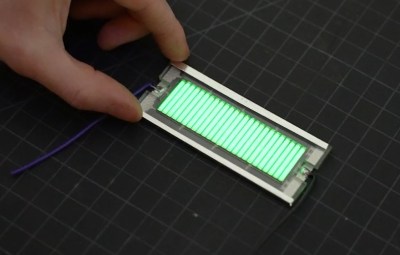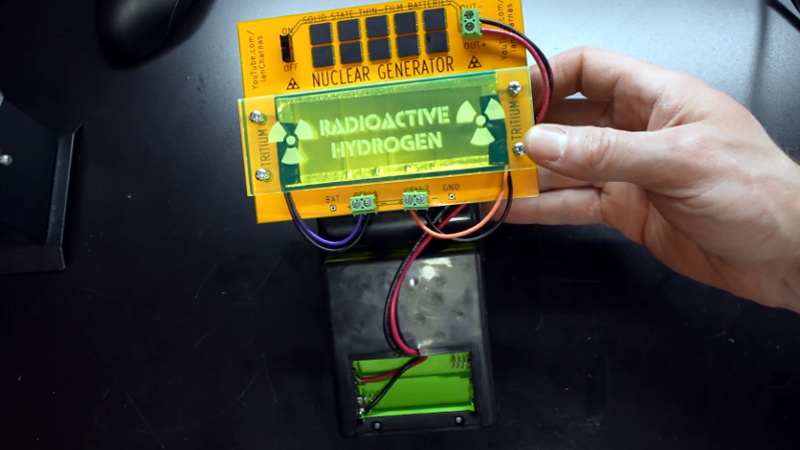The idea of a tritium power cell is pretty straightforward: stick enough of the tiny glowing tubes to a photovoltaic panel and your DIY “nuclear battery” will generate energy for the next decade or so. Only problem is that the power produced, measured in a few microwatts, isn’t enough to do much with. But as [Ian Charnas] demonstrates in his latest video, you can eke some real-world use out of such a cell by storing up its power over a long enough period.
As with previous projects we’ve seen, [Ian] builds his cell by sandwiching an array of keychain-sized tritium tubes between two solar panels. Isolated from any outside light, power produced by the panels is the result of the weak green glow given off by the tube’s phosphorus coating as it gets bombarded with electrons. The panels are then used to charge a bank of thin-film solid state batteries, which are notable for their exceptionally low self-discharge rate.
 Some quick math told [Ian] that a week of charging should build up enough of a charge to power a knock-off handheld Tetris game for about 10 minutes. Unfortunately, after waiting the prescribed amount of time, he got only a few seconds of runtime out of his hacked together power source.
Some quick math told [Ian] that a week of charging should build up enough of a charge to power a knock-off handheld Tetris game for about 10 minutes. Unfortunately, after waiting the prescribed amount of time, he got only a few seconds of runtime out of his hacked together power source.
His best guess is that he got a bad batch of thin-film batteries, but since he could no longer find the exact part number he used originally, he had to design a whole new PCB for the second attempt. After waiting two long months to switch the game on this time, he was able to play for nearly an hour before his homebrew nuclear energy source was depleted.
We wouldn’t consider this terribly practical from a gaming standpoint, but like the solar harvesting handheld game we covered last year, it’s an interesting demonstration of how even a minuscule amount of power can be put to work for intermittent applications. Here it’s a short bout of wonky Tetris, but the concept could just as easily be applied to an off-grid sensor.
[Thanks to Dan for the tip.]
















If you can avoid the hydrogen escaping, you should get more power if all the material that absorbed beta radiation was removed, allowing the beta particles to hit the voltaic materials directly to generate a higher voltage.
https://en.wikipedia.org/wiki/Betavoltaic_device
Glen – super comment! I totally agree. Betavoltaic devices would generate more power. I don’t have the equipment to make one, so I did the best I could :-)
This was my first thought, too, but then…
OT1H you go directly from electrons to moving charges. But you have a huuuge impedance mismatch between those betas (~17 keV) and those semiconductor junctions (~ few eV). OT2H, one beta at 17keV will probably kick off quite a few “visible” photons (again in the “few eV” range).
So perhaps the fluorescent goo isn’t that bad as an impedance match layer of sorts?
Sorry, no napkin around for further calculations :-)
You might get a better impedance match with a diamond photocell. Or cubic borazon..
But you would also expect each beta partcle to create dozens (hundreds?) of carrier pairs as it rips through the medium, settling down to thermal energy levels. Better to have that happen in a rectifying medium than in plastic. (Provided no permanent damage is done by the beta particles)
This would be a perfect powersource for my to use on my phantomos operating system.
So Wal-mart had a sale on nuclear isotopes or something?
Nuka Brand, Inc., in collaboration with Poseidon Energy, bring you this hack for free.*
*Purchase of 6 pack of Nuka Quantum Cola required. Nuka Brands not responsible for any burns, DNA damage, or criticality incidents.
He wen’t out to Pickering with a Mason jar.
Great project ! I remember something similar back in the 90’s of a cube of glowing radioisotope surrounded by solar cells more sensitive to the frequency of light for better power output. It was supposed to be a future battery. Apparently it never happened and we don’t have perpetual batteries.
Has Ian considered tying his perpetual power generator (PPG) to super capacitors instead of the thin film batteries ? Are the thin film batteries more power dense/less leakage/cost effective than a supercap ? This gives me an idea for a project (like I need another one… 😁)
Did you read the article at all?
“notable for their exceptionally low self-discharge rate.”
Also it might be more convenient when it’s a flat chip like that for some applications
Yes I did see that I thought supercaps had a low self discharge rate as well. Did you read the question I posed ? Is the thin film battery better than supercaps ?
In the video, he shows the supercaps he could find had a high discharge rate which ultimately landed him on those thin film batteries… Which are apparently hard to come by these days…
Yeah. Watched the video (on double speed – unfortunately youtube won’t go faster) and found the manufacturer of the batteries.
To say I am disappointed is an understatement: they claim “58 patents” and ‘trade secrets’ on their battery technology, so I head over to the products page… to read “EnerChip™ Packaged Batteries – Discontinued and not available”.
WTF! How can a company patent something and then refuse to make it! No wonder this world is so screwed up. If you don’t make it, and don’t/won’t licence it to someone who will, then anyone else making it should be able to sidestep any patents you have!
Cymbet (the manufacturer): the words used to describe them are not suitable for this forum!
Garth – great question! Supercapacitors have much more power density, which is good, but sadly they discharge too quickly. The nuclear generator only outputs about 1.5 microwatts, and which is smaller than the self discharge rate of supercapacitors. It was a real challenge finding a way to store such a tiny amount of energy because almost everything I could think of ended up having too high of a self discharge rate. The only things that I found that would work are the thin film solid state batteries.
Thanks for the comment!
Thanks ! I don’t know anything about thin film batteries and in the past there have been articles about supercaps will soon be a battery replacement. So the film batteries lower leakage means effectively a smaller hole in the bucket you are trying to fill. 😁
You could certainly run a digital clock — a standard digital watch only requires a microwatt or so. Certainly, you could also run a digital volt-meter where one uses a micro-power band-gap reference. Also, you could run micro-power analog circuits to create most anything with respect to temperature sensing, light sensing, even pressure sensing.
Is there a low power Geiger counter that could be run off the power? It wouldn’t be very useful but quite meta.
Sam, that’s a super idea! I found this stack exchange post which corroborates your concept.
https://electronics.stackexchange.com/questions/200239/how-do-digital-watches-use-so-little-power-and-how-do-i-do-that
Their watch used about 2 microamps, at (presumably) 1.5 volts, which would be 3 microwatts.. so if I built two of my nuclear generators it would make for quite the timepiece! Definitely a conversation starter. Especially with airport security, LOL. :-)
I’ve watched the NurdRage version of this a while back. I’m actually more interested in the chip-battery introduced here.
I totally love the stuff that NurdRage does. I credited him in the video, and I hope I made a significant or interesting enough addition with the solid state batteries so that it doesn’t seem like I’m just copying him. He’s awesome.
-Ian Charnas
Hey Ian, I actually loved that you introduced the chip batteries that I was inclined to order some myself. I was totally impressed that you were able to power the thing for way longer than you expected and that really piqued some application ideas for the chip battery. So, thanks a lot to you too :)
If you could coat the tubes directly with materials that make a PV cell, and have it be ideally matched to the light frequency, that would maximize the tiny output.
Gregg, thanks for the comment! I was thinking the same thing about wanting the phosphor output to match the PV cell junction’s operating wavelength. I couldn’t find enough info in the datasheets to make an informed decision, so I bought a bunch of options and tested them to get an empirical sense of what worked best.
Gregg – great comment! I was thinking the same thing about trying to find a PV cell with a junction that operates at the same wavelength as the light emitted by the phosphors. I couldn’t find that info in the datasheets so I just bought a bunch of options and tested them to empirically find a good choice.
Might be able to boost the output slightly by finding a phosphor coating whose output matched the absorption of the PV cells
once a week for ten minutes of game play – that’s about all that kids should be allowed to play – they need to spend the rest of their free time learning to become Makers
“But you would also expect each beta partcle to create dozens (hundreds?) of carrier pairs as it rips through the medium …”
Very good point. Then you’d want the beta to rip along the semiconductor junction, or, perhaps even better, to have thousands of junctions stacked and send the particle across?
Hi
where I can acquire material for replicate this project?
Hi! Good question. I linked to the main materials in this instructable:
https://www.instructables.com/DIY-Nuclear-Generator/
Hi, good question! Check out the “supplies” section in this instructable:
https://hackaday.com/2021/07/14/tetris-handheld-powered-by-tritium-cell-eventually/
For the thin film batteries, try RightPartsOnline.com